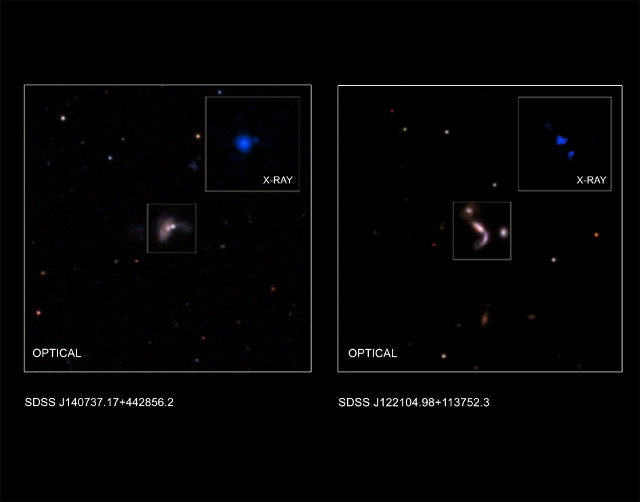
Two articles, one recently accepted for publication in “The Astrophysical Journal” and one published in the journal “Monthly Notices of the Royal Astronomical Society” (MRAS), describe as many researches on pairs of supermassive black holes. In total, five candidates could form as many pairs of black holes with masses millions of times the Sun’s at the center of galaxies. At a time when gravitational wave research obtained historical results, very powerful sources could be very useful for new studies.
Shobita Satyapal of George Mason University in Fairfax, Virginia, first author of the article accepted for publication in “The Astrophysical Journal” and among the authors of the one published in MRAS, reminds us that astronomers discovered supermassive black holes everywhere in the universe. Instead, pairs are hard to find and according to the authors of a research published in the journal “Nature” in September 2015 they’re rare.
Until now, very few pairs of growing supermassive black holes have been confirmed, discovered by X-ray studies based on lucky detections. To perform a systematic research, this time it was necessary to examine data collected by telescopes working at different electromagnetic wavelengths.
Using data on the Sloan Digital Sky Survey (SDSS) at optical wavelengths, the researchers identified galaxies where a merger was in progress. From that group, they selected objects where the separation between the two galactic centers was less than 30,000 light years, and the infrared data detected by NASA’s WISE space telescope was the same as those for a rapidly growing supermassive black hole.
In this way they found seven merging galaxies that contain at least one supermassive black hole. X-rays are a kind of mark for the growing ones, so those galaxies were observed with the Chandra space telescope, which works at those frequencies. Pairs of relatively close X-ray sources were identified in five of those galaxies, strong indications of the presence of pairs of growing supermassive black holes.
The research published on MRAS, of which Sara Ellison is the first author, also used data from the Mapping Nearby Galaxies at Apache Point Observatory (MaNGA) survey to identify one of the pairs of supermassive black holes. One of the two members of the pair has the highest X-ray brightness observed so far in a black hole by Chandra.
Sara Ellison stated that using infrared observations to select the objects to be observed with a follow-up at X-rays is a very effective way to find black hole pairs. The radiations at those frequencies can pass through the gas and dust clouds surrounding those black holes and Chandra allows to separate them.
The top image shows two of the possible supermassive black hole pairs identified thanks to the combination of data obtained from various telescopes at different electromagnetic frequencies (X-ray (J122104): NASA/CXC/George Mason Univ./S.Satyapal et al.; X-ray (J140737): NASA/CXC/Univ. of Victoria/S.Ellison et al.; Optical: SDSS; Illustration: NASA/CXC/A.Hobart).
Gravitational wave-based astronomy born with the recent successes of the LIGO/VIRGO collaboration can benefit greatly from this type of discovery. So far, those waves have been detected from normal black holes but a merger of supermassive black holes would produce far greater effects. If a pair of that type were close to a merger from the Earth’s point of view, the detections could be spectacular.


